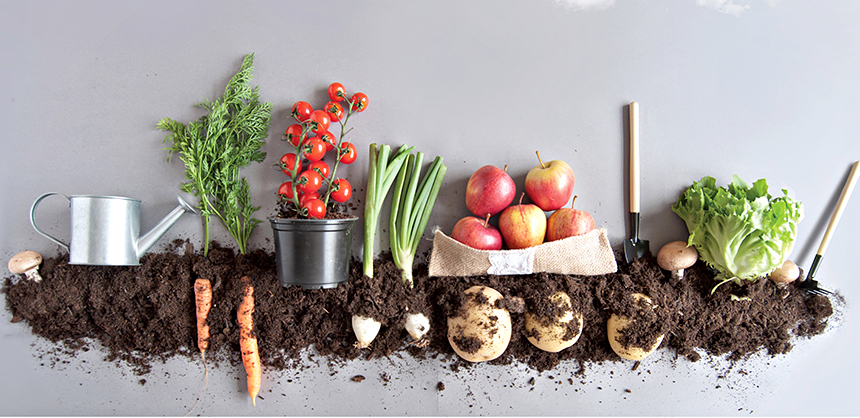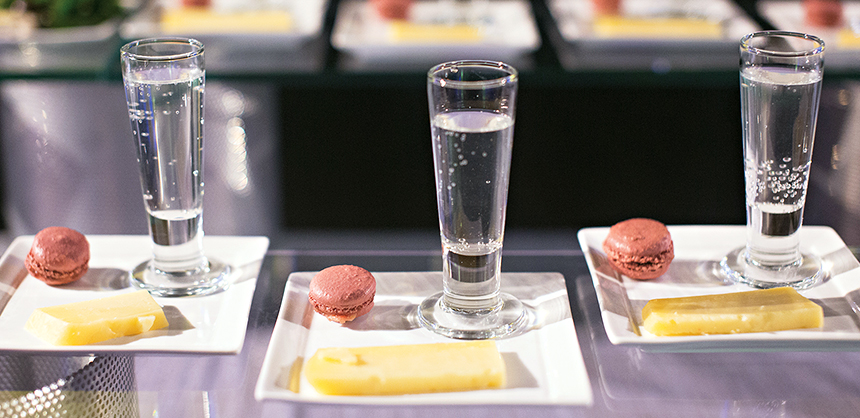Monumental Menus: These F&B Trends Will Continue To Dominate Going ForwardMay 21, 2020
By Maura KellerMonumental Menus: These F&B Trends Will Continue To Dominate Going Forward

Emily Parker-Woodland, marketing expert at Lola.com, says DIY meals are very popular. “Not only does it allow people to select the food they want and make it in the way they like, but lines for the buffet are one of the best times to network with fellow attendees.”
Every year or two, new trends grab hold of the food and beverage components of meetings and events. From sustainably farmed salmon to tasty kombucha concoctions, to chickpea pasta, these types of innovative trends are taking the meeting industry by storm.
Going Green
Melissa Panico, director of marketing at the event planning and catering company, Taste Catering, is seeing the trend of food and beverages leaning toward the environmental footprint of the culinary aspect of an event, along with the movement toward sustainability. Essentially, Panico’s clients are embracing the trend of reducing their event’s carbon F&B footprint.
“With the rise of the fires here in Northern California due to climate change, local companies are aware of the importance of a carbon footprint,” Panico says. “Events can be very wasteful in terms of garbage and water.”
Sustainable and “green” food and beverage options are now viewed as an easy avenue to please attendees. That said, it’s important to define what “green” means within the food and beverage industry. Green menus include products or services that reduce the health and environmental impacts.
Along those lines, “the biggest trends our members are seeing are locally sourced ingredients, natural and healthy foods,” says Jamie Huckleberry, Event Service Professionals Association (ESPA) president and director of event services at the David L. Lawrence Convention Center in Pittsburgh, Pennsylvania. “We are seeing a consistent trend of farm to table among our clients. The chef and culinary staff focus on making gluten-free parts of each menu option knowing that it is a strong request for every event.”
So why the push toward sustainable food and beverages? The simple reason that these efforts continue to gain momentum is because people want products and services that are safer, healthier and have a reduced impact on the environment. And, because everything is so competitive, it gives caterers an opportunity to meet this growing awareness and differentiate from their competition.
“Thankfully, this focus is happening on all parts of events but, food is definitely an important one and I’m seeing it more,” says Emily Parker-Woodland, marketing expert at Lola.com, a travel management app company where Parker-Woodland manages events for the company. “Planners are opting for caterers who go the extra mile to ensure food is sourced ethically and with sustainable practices, and picking reusable or compostable utensils instead of one-time use plastic.”
Indeed, while sustainable menu options are key, meeting planners also are turning their attention to such things as incorporating “green” utensils, which can include bamboo, woodand compostable options for guests.
Embracing Interactivity
Paul Ruby, CMP, ESPA member and director of conference services and events at The Lodge at Gulf State Park, says their director of food and beverage is filling more and more requests for interactive stations, which also is a new trend. Other convention services managers (CSM) say clients are asking for creative presentations above and beyond the standard chafing dish or soup terrine.
“Family style service has increased at our facility, which allows for networking and more conversation at the table,” Huckleberry adds. “It also decreases the need for centerpieces, which allows for the food to be the centerpiece and decreases ancillary costs to the client, such as floral or candles.”
At the Tampa Convention Center in Tampa, Florida, the staff continues to see clients diving into the room set up and how their guests will utilize food and beverage stations. “Our clients are highly engaged with the idea of how guests interact with each other and how they can create spaces that encourage more networking,” says Suzanne Seder, CMP, ESPA member and director of convention services at the Tampa Convention Center, who works alongside Jason Orchard, food and beverage manager of events. “This has become a part of how we operate as food and beverage professionals in this day and age.”
Another trend Ruby sees includes clients requesting to have meals or receptions outside the traditional ballroom setting. “Non-traditional venues are gaining in popularity and are not just having events in the meeting space contracted,” he said. “Beach and pool area setups are top requests for our location.”
According to Todd Peplinski, chief curator at Highlands Events, a new culinary and events destination atop Detroit’s iconic GM Renaissance Center, engaging and entertaining clients continues to be key in meetings and events. For example, the Highlands menu focuses on chef-attended food stations that get guests moving around the room, providing vignettes for customer focus and engagement — all while showcasing locally sourced and sustainable food and beverage options.

“One of the largest food trends that has evolved greatly over the past few years has been the vegetarian/vegan menu selections that have been added to mainstream menus,” Peplinski says. “Clients are not only looking for options for one or two of their guests but they are looking at ways to incorporate those items into the mainstream offerings for everyone to taste.” Culinary teams are concentrating on flavors to surpass the expectation that most guests have for vegetarian/vegan items as well as gluten-free options, which has also become a common request.
Peplinski also is seeing larger events beginning to become more adventuresome with regard to overall menu options — keeping key traditional items for the locale but highlighting new, vibrant items to create a buzz and talking points regarding the event.
“Comfort food stations combined with cutting edge passed hors d’oeuvres allows guests to enjoy the best of both worlds,” Peplinski says.
Andy Snow, president at Feastivities Events, says that clients are savvy and will know the trends — possibly before you do.
“Is there anything worse than a client suggesting a food trend that you aren’t familiar with?” Snow asks. “Meat is no longer the only source of protein. Seeds, lentils, quinoa, chickpeas, hemp, flax and split peas will take center stage on the dinner plate at receptions. Clients want convenient, sophisticated food experiences, fresh, natural, additive-free food and they need transparency in the source and the way it’s prepared. Embrace this; it’s not going away.”
Event attendees also expect their food to be unique and exciting, while being ethically produced with locally sourced, environmentally friendly ingredients. Clients want their food to have a story. Where did it come from? What about the small business? The farm? Is it socially responsible?
“We are seeing a trend away from beef and toward more health conscious snacks and grab-n-go lunch options,” Panico says. “Companies are requesting beef-free menus, hence the popularity of Impossible Beef sliders” from the Impossible Foods company, which develops plant-based substitutes for meat products.
Panico’s clients are moving away from the typical box lunch and wanting more ethnically inspired and vegan or vegetarian meals, rather than a choice of three different sandwich boxes from which to choose.
“With beverages, clients might want the same health options, requesting kombucha on tap, spa water and green juice, instead of the typical orange juice and grapefruit options,” Panico says.
German Villatoro, director of culinary at Convene, says the global trending flavors are welcomed in many menus, which has led Villatoro in incorporating them in a “perfect plate” approach.
“Our clients love the well-thought-out menus with eclectic flavors from all over the world,” Villatoro says. “People are more educated on food these days and are taking chances on trying different types of food.” At Convene, you will find them serving healthy dishes with bright and bold flavors, such as traditional dishes like “Pozole Verde” and “Thai Curried Pumpkin.”
Parker-Woodland also says the way food is presented is also changing within the meetings and events industry. “Sitting at an assigned table waiting for someone to bring you a plate is a thing of the past. Instead of forcing attendees to stay seated waiting around, I’m seeing more passed apps and DIY meals like tacos, rice bowls and salads,” Parker-Woodland says. “Not only does it allow people to select the food they want and make it in the way they like, but lines for the buffet are one of the best times to network with fellow attendees.”
With smaller groups, Panico says event planners can definitely have more involved, creative food items that have several ingredients and interesting elements put together on site.
Larger group food items need to be easier to grab and go, with fewer ingredients to assemble. “Some needs to be stackable on a station to accommodate large groups coming to a table all at once,” Panico says. “Setting the client expectations in advance of this is important. There should be a carefully designed menu, food that can stack and be easily replaced on platters.”
One way to keep waste down and control portions is to present “chef-attended” stations as menu options. This way, food is prepared creatively and interactively without over-production resulting in waste. And there is more food control with this situation.

Small plates, which allow attendees to sample a variety of foods presented appetizer-style, remain popular.
Thirst Quenching Trends
As far as beverage trends, pairing the cocktail to the food is very popular within today’s meetings and events.
“Coffee-inspired drinks and kombucha have to be on top of my list of the biggest drink trends for meetings, but with the increase in health and wellness, kombucha wins,” Villatoro says.
According to Parker-Woodland, drink tickets are out. “I don’t know the last time I attended an event where drink tickets were given out. Instead of giving people one to two drinks max, planners are going with beer and wine bars and cutting out liquor and other fancier drinks,” Parker-Woodland says. “This is good for your budget, and it makes attendees feel very VIP with a fully open bar.”
That said, signature drinks are definitely a favorite among attendees. For planners who don’t want to go with only beer and wine, they are opting for signature drinks to limit the selection and overall cost, but still give attendees a choice.
“Plus signature drinks are a great way to display your brand with fun drink names,” Parker-Woodland says.
Ruby adds that beverage trends are reflecting the movement toward the local experience, with clients requesting craft and local beers for the flavor of the destination.
“Local craft brewery partnerships are a big hit; providing educational bars, blending classes, wine classes and bourbon bars are all continuing to show positive results,” Ruby says. “People want to learn — not just get another drink.”
Guests also want what is trending outside the conference rooms. Huckleberry’s clients are asking for hard seltzers, which are the “in” drink of the moment with low carbs and low calories.
Of course, coffee is not going anywhere — if anything, it is gaining more attention. “Coffee is also a big deal; no conference would be complete without the coffee station, but that, too, is evolving,” Huckleberry says. “Coffee presentation has evolved to include cold brew, nitro coffee, iced coffees and gourmet specialties.”
And whiskey programs, tastings and pairings also are becoming increasingly popular. How the whiskey is aged and how it is combined with unique flavor components for craft cocktails are great talking points and add an educational component to an event.
“Apertifs and creating a more European-style ‘cocktail hour’ with emphasis on celebrating the end of the day and the coming together of family and friends not only tempts the appetite but also helps to sustain the sharable plate concepts,” Peplinski says. “Mocktails have become increasing popular as well — creating an additional option for the typical smoothie or soda break with great flavor and colors without the alcohol.”
Full Steam Ahead
Peplinski suggests meeting and event planners partner with culinary teams to find out what is hot on dining room menus and look for ways to bring those new items into the banquet world.
“When a client brings an idea from a restaurant experience they have had we try to find a way to say ‘Yes’ to serving it to a large group with a dynamic presentation while keeping the flavor component consistent with the original experience,” Peplinski says. “New ideas and presentations are born out of the partnerships all the time.”
Villatoro also recommends meeting and event planners ask about doing a tasting of the seasonal menu so they can taste for themselves whether or not the choices are too trendy for guests.
“Planners should always meet the chef in order to understand and get clarity on the trending dishes,” Villatoro says. “My best tip is to avoid creating your own menu and trust the chef.”
Top tips from others include reviewing event history to see what worked and what didn’t work from past events and not falling into the trap where the planner asks for attendee preferences instead of allergies or restrictions.
“Meet the chef in person, find out their passion, ask about seasonal menus and what local farmers, bakeries, and providers of seafood, cattle, eggs, honey, etc. they have local partnerships with,” Ruby says. “Ask about advance ordering. Do not assume that everything can be purchased in large quantities or will be available using the industry standard of providing guarantees three days out.”
So what does the future hold for food and beverage offerings? Experts agree that the continuation of the hot ingredient search will continue — the next quinoa or the next kombucha.
Snow says African-Caribbean (Afro-Carib) cuisine is the latest food in this area. It draws inspiration from the Northern half of Africa and the Caribbean, “with an emphasis on distinct spice mixes, composed mainly of seafood and flavorful cuts of meat, yams, cassava, plantain, sweet potatoes, cocoyam, coconut, lentil, rice and bread — so tasty and unique,” Snow says. In general, the cuisine has some heat, so chefs will need to lighten up the spices for the American palate.
“The future is bright for food and beverage trends and continues to evolve,” Villatoro says. “If you consider the plant-based diets and dishes out there, this has been a massive boom for them. Look out for more eclectic menus and offerings. We will continue to push the boundaries with global flavors and educate our guests about offering up something new.”
For Peplinski, one of the biggest recommendations he has for planners to curate the events is to find the small details that clients are looking at and introduce those specific details into the overall food and beverage programs.
Including rich cultural foods, ethnic foods and keeping in mind beverage traditions are great ways to enhance the overall event experience, Peplinski says. He adds, “Increasing awareness of sustainable food options — where and how the food product arrives at its final preparation destination — will become more important to clients as well.”
And the use of tech with the presentation and entertainment of food will continue to escalate. The ‘Instagram’ moment is still very popular and combining food with petite beverage samples helps to promote not only creativity, but increases to the bottom line while providing social media marketing opportunities.
Huckleberry expects the sustainability trend will spread to the venues themselves. “We are seeing venues starting to grow their own food or focusing on a specialty item,” Huckleberry says. “As an example, we grow our own hops and team up with a local brewery to create our signature beer, Rooftop Hops. We also grow our own vegetables and herbs, which are used in our menus and served to our guests. Other venues have bees for making honey and chickens for eggs. I believe this will become more popular as the years continue.” AC&F










